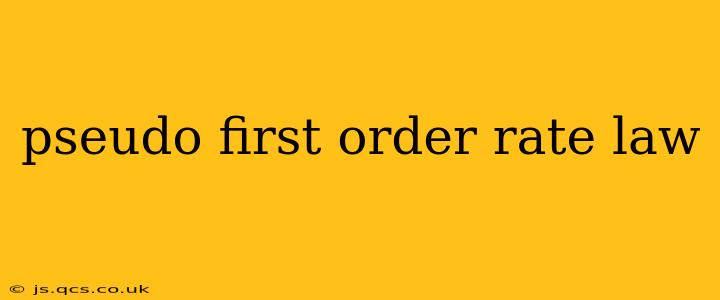The pseudo first-order rate law is a powerful tool in chemical kinetics used to simplify complex reactions and make them easier to study. It's particularly useful when dealing with reactions involving multiple reactants, where one reactant is present in significant excess compared to others. This seemingly simple concept can significantly impact how we understand and model reaction rates. This guide will explore the fundamentals of the pseudo first-order rate law, its applications, and common misconceptions.
What is a Pseudo First-Order Reaction?
A pseudo first-order reaction is a reaction that appears to follow first-order kinetics, even though it's actually a higher-order reaction. This happens when the concentration of one reactant is significantly larger than the concentration of the other reactants. The concentration of the reactant in excess remains essentially constant throughout the reaction. Because its concentration doesn't change appreciably, it can be incorporated into the rate constant, effectively simplifying the rate law.
Let's consider a general second-order reaction:
A + B → Products
The rate law for this reaction is typically:
Rate = k[A][B]
However, if the concentration of B is much greater than the concentration of A ([B] >> [A]), then the concentration of B remains nearly constant during the course of the reaction. We can then treat [B] as a constant and combine it with the rate constant, k:
Rate = k'[A]
where k' = k[B]. This new rate constant, k', is called the pseudo first-order rate constant. The reaction now appears to follow first-order kinetics with respect to A, even though it's fundamentally a second-order reaction.
Why Use the Pseudo First-Order Rate Law?
The primary advantage of using the pseudo first-order rate law lies in its simplification of complex reaction kinetics. By making one reactant concentration effectively constant, we can:
-
Simplify data analysis: First-order kinetics are much easier to analyze than higher-order kinetics. The integrated rate law is simpler, and plotting the data gives a straight line, making it easy to determine the rate constant.
-
Determine individual rate constants: In complex reactions with multiple steps, using the pseudo first-order approach can help isolate and determine the rate constant for a specific step.
-
Study reactions with slow steps: The excess reactant can be used to ensure that a slow step in a multi-step reaction becomes rate-determining.
How to Determine if a Reaction Follows Pseudo First-Order Kinetics
To determine if a reaction follows pseudo first-order kinetics, you need to perform experiments with varying concentrations of the reactants. If changing the concentration of one reactant significantly affects the reaction rate, while changing the concentration of another reactant has little to no effect, then the reaction is likely pseudo first-order. The rate constant should remain constant when the concentration of the excess reactant is varied, while the initial concentration of the other reactant should show the expected first order relationship.
Examples of Pseudo First-Order Reactions
Many reactions in organic chemistry and biochemistry fall into this category. Enzyme-catalyzed reactions, for instance, often exhibit pseudo first-order kinetics when the substrate concentration is much higher than the enzyme concentration. The hydrolysis of esters in the presence of a large excess of acid is another common example.
Common Misconceptions about Pseudo First-Order Rate Laws
-
It's not a true first-order reaction: Remember, the reaction is only pseudo first-order. The underlying reaction mechanism is still higher-order.
-
The excess reactant concentration doesn't change: While the change is negligible, the concentration of the excess reactant does technically change during the reaction. However, the change is so small that it doesn't significantly affect the rate.
-
It only applies to second-order reactions: The concept can be extended to higher-order reactions where one or more reactants are in significant excess.
Conclusion
The pseudo first-order rate law is a valuable tool for simplifying kinetic studies of complex reactions. By understanding its principles and limitations, researchers can effectively analyze reaction rates, determine rate constants, and gain a deeper understanding of reaction mechanisms. The ability to simplify complex scenarios is a significant strength within the world of chemical kinetics.
